Heinrich, thank you for taking the time to post the history of the ship and the discussion of the name, etc. It has all worked its magic on me and I can't wait to see the model unfold in your capable hands.
-

Win a Free Custom Engraved Brass Coin!!!
As a way to introduce our brass coins to the community, we will raffle off a free coin during the month of August. Follow link ABOVE for instructions for entering.
-

PRE-ORDER SHIPS IN SCALE TODAY!
The beloved Ships in Scale Magazine is back and charting a new course for 2026!
Discover new skills, new techniques, and new inspirations in every issue.
NOTE THAT OUR FIRST ISSUE WILL BE JAN/FEB 2026
You are using an out of date browser. It may not display this or other websites correctly.
You should upgrade or use an alternative browser.
You should upgrade or use an alternative browser.
HIGH HOPES, WILD MEN AND THE DEVIL’S JAW - Willem Barentsz Kolderstok 1:50
- Joined
- Jan 9, 2020
- Messages
- 10,544
- Points
- 938

I am very glad that you enjoyed the discussion Paul and I am really glad to have you here. Your work on the Vasa is absolutely magnificent and and your input will be most valuable. Welcome again!Heinrich, thank you for taking the time to post the history of the ship and the discussion of the name, etc. It has all worked its magic on me and I can't wait to see the model unfold in your capable hands.
Nice to see you have opened the box, Heinrich. It looks very nice.
But ........ where is the note-block?
Some guys ordered that note-block by Kolderstok and got it delivered with as extra a ship.
Regards, Peter
But ........ where is the note-block?
Some guys ordered that note-block by Kolderstok and got it delivered with as extra a ship.
Regards, Peter
All of a sudden I stumbled upon your log, Heinrich. I like the intro you gave here, with information I did not know before. It does add a lot to the story of Willem Barentsz and his ship. When building #1 (which is standing on my desk here) we did not know any name of the ship, and as far as we knew there was no clue which could lead to a specific name. Therefore we decided to put the (a bit dramatic) sentence on the box: The name of his ship remains unknown to this day.
I am speaking about "we" because my eldest son Michiel (named after, yes, Michiel de Ruyter) does the design of all the Kolderstok boxes and we often have nice and also though discussions about what I want and he says is not how it should be (he has studied designing and printing technology -but not only that, he has also studied on the Willem Barentsz Nautical college on Terschelling). And right after the first boxes where printed the message came that the name of the ship could very well be Swaan, or Witte Swaan.
I have made a small comment in the building instructions about the name, but we decided not to change the box anymore.
About the box: at school at the history lessons we often got our information from a large on linen printed image which showed a specific situation. The teacher then told us the story which was shown on the image.
Het behouden Huys - the house in which the crew spent the winter on Nova Zembla has always been an important part of the Dutch history, and therefore it has been one of the images printed on linen for educational purposes.
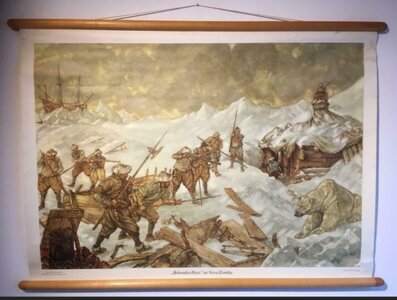
If you look at the box you can see parts of this painting.
Thanks to the generous gift of a Dutch model builder I do have this printed linen in my personal collection. It is not really rare, but it is very nice to have.
Hans
I am speaking about "we" because my eldest son Michiel (named after, yes, Michiel de Ruyter) does the design of all the Kolderstok boxes and we often have nice and also though discussions about what I want and he says is not how it should be (he has studied designing and printing technology -but not only that, he has also studied on the Willem Barentsz Nautical college on Terschelling). And right after the first boxes where printed the message came that the name of the ship could very well be Swaan, or Witte Swaan.
I have made a small comment in the building instructions about the name, but we decided not to change the box anymore.
About the box: at school at the history lessons we often got our information from a large on linen printed image which showed a specific situation. The teacher then told us the story which was shown on the image.
Het behouden Huys - the house in which the crew spent the winter on Nova Zembla has always been an important part of the Dutch history, and therefore it has been one of the images printed on linen for educational purposes.

If you look at the box you can see parts of this painting.
Thanks to the generous gift of a Dutch model builder I do have this printed linen in my personal collection. It is not really rare, but it is very nice to have.
Hans
BTW - regarding the name of the ship: When you have a good look at the box you will see we call it: Het expeditieschip van Willem Barentsz. (the expedition ship of Willem Barentsz)
But almost everyone nowadays refers to the Willem Barentsz when talking about the Kolderstok model. Can't help it, can't change it.
Hans
But almost everyone nowadays refers to the Willem Barentsz when talking about the Kolderstok model. Can't help it, can't change it.
Hans
- Joined
- Sep 3, 2021
- Messages
- 5,155
- Points
- 738

And do I remember this painting, even when it's 60-odd years ago...All of a sudden I stumbled upon your log, Heinrich. I like the intro you gave here, with information I did not know before. It does add a lot to the story of Willem Barentsz and his ship. When building #1 (which is standing on my desk here) we did not know any name of the ship, and as far as we knew there was no clue which could lead to a specific name. Therefore we decided to put the (a bit dramatic) sentence on the box: The name of his ship remains unknown to this day.
I am speaking about "we" because my eldest son Michiel (named after, yes, Michiel de Ruyter) does the design of all the Kolderstok boxes and we often have nice and also though discussions about what I want and he says is not how it should be (he has studied designing and printing technology -but not only that, he has also studied on the Willem Barentsz Nautical college on Terschelling). And right after the first boxes where printed the message came that the name of the ship could very well be Swaan, or Witte Swaan.
I have made a small comment in the building instructions about the name, but we decided not to change the box anymore.
About the box: at school at the history lessons we often got our information from a large on linen printed image which showed a specific situation. The teacher then told us the story which was shown on the image.
Het behouden Huys - the house in which the crew spent the winter on Nova Zembla has always been an important part of the Dutch history, and therefore it has been one of the images printed on linen for educational purposes.
View attachment 272269
If you look at the box you can see parts of this painting.
Thanks to the generous gift of a Dutch model builder I do have this printed linen in my personal collection. It is not really rare, but it is very nice to have.
Hans
Hi Heinrich,
A nice discussion here already before you showed the first parts of the build .
.
If you want to add something to the build to be sure of you can add this famous clock.
It was onboard during the whole expedition and was also used in "het behouden huis". This is the real clock that made the whole trip and that maybe Willem Barentz winded himself . It was recovered from the remains of het behouden huis at Nova Zembla in 1872.
. It was recovered from the remains of het behouden huis at Nova Zembla in 1872.

In 1599 a book with the story of Gerrit van de Veer, survivor of the expedition, was published including some drawings. On the cut away drawing of het behouden huis you see the clock in the upper right corner.
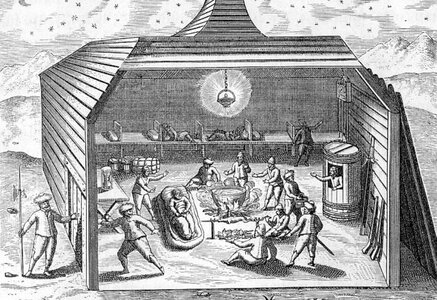
Now it is in the Rijksmuseum with a lot of other remenants of the trip.
So that adds a certainty to your build.
A nice discussion here already before you showed the first parts of the build
If you want to add something to the build to be sure of you can add this famous clock.
It was onboard during the whole expedition and was also used in "het behouden huis". This is the real clock that made the whole trip and that maybe Willem Barentz winded himself

In 1599 a book with the story of Gerrit van de Veer, survivor of the expedition, was published including some drawings. On the cut away drawing of het behouden huis you see the clock in the upper right corner.

Now it is in the Rijksmuseum with a lot of other remenants of the trip.
So that adds a certainty to your build.
- Joined
- Jan 9, 2020
- Messages
- 10,544
- Points
- 938

Hi Peter. I just could not resist opening it and smelling that wonderful wood smell. And the Notepads ... I got TWO!!!Nice to see you have opened the box, Heinrich. It looks very nice.
But ........ where is the note-block?
Some guys ordered that note-block by Kolderstok and got it delivered with as extra a ship.
Regards, Peter
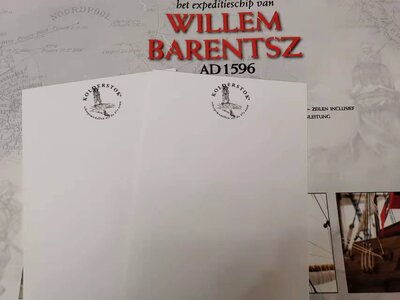
- Joined
- Jan 9, 2020
- Messages
- 10,544
- Points
- 938

Thank you for the kind comments Hans and all the additional information - it adds so much to the history of the ship! To me, it will always be the Willem Barentsz ... but then, that's just me!BTW - regarding the name of the ship: When you have a good look at the box you will see we call it: Het expeditieschip van Willem Barentsz. (the expedition ship of Willem Barentsz)
But almost everyone nowadays refers to the Willem Barentsz when talking about the Kolderstok model. Can't help it, can't change it.
Hans
- Joined
- Jan 9, 2020
- Messages
- 10,544
- Points
- 938

@Maarten Welcome Maarten - you don't even have to ask for a seat - you have the balcony and opera binoculars!
That is great information about the clock. I have read that the men would while their time playing board games and "watching the clock". Now we can actually attach a picture to the clock. If ever that was a ship that begged for a diorama or special display, it's the Willem Barentsz. I can just imagine what you would have come up with as a display if you were to build her. Icebergs, polar bears, Het Behouden Huys ... ?
That is great information about the clock. I have read that the men would while their time playing board games and "watching the clock". Now we can actually attach a picture to the clock. If ever that was a ship that begged for a diorama or special display, it's the Willem Barentsz. I can just imagine what you would have come up with as a display if you were to build her. Icebergs, polar bears, Het Behouden Huys ... ?
The other guys have said it all Heinrich- another incredible historical introduction to your build- exciting. I see all the front row chairs have been taken so i will also pull up my deck chair and gate crash this build.@Ab Hoving Thank you very much Ab. That clears things up completely as far as the name goes. Hans's interpretation of the taffrail (which he no doubt researched well) is thus a very likely one - if not the most likely.
View attachment 272206

- Joined
- Jan 9, 2020
- Messages
- 10,544
- Points
- 938

Hi Grant! Great to see you here - a South African who lives in Melkbosstrand and who is building such an exquisite HMS Victory as you are - can gatecrash my party anytime !The other guys have said it all Heinrich- another incredible historical introduction to your build- exciting. I see all the front row chairs have been taken so i will also pull up my deck chair and gate crash this build.
- Joined
- Jan 9, 2020
- Messages
- 10,544
- Points
- 938

The next step entails the making of the two deck hatches for the lower deck (Deck A) – a larger one which is just in front of the main mast and a smaller one towards the stern of the ship.
The instructions call for the hatches to be assembled from walnut strips of 6mm width and 1.5mm thickness with a 2mm x 2mm walnut strip as frame. In the case of the bigger hatch, I found that 7 strips plus the frame give the desired size whilst the smaller hatch can be made up of three strips plus the frame. In both cases the strips run across the deck (starboard-port direction) and are finished by two 6mm strips which are mounted lengthwise (stem-to-stern) on top of the hatch.
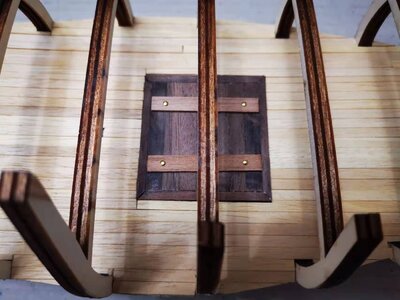
Front hatch installed.

Graphic illustration of the how the front/larger hatch is composed.
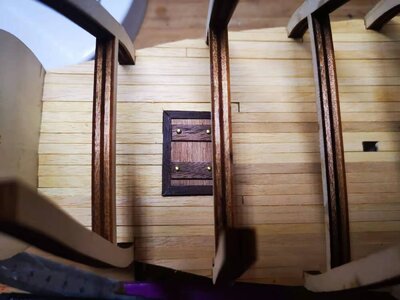
Smaller hatch at the stern installed.
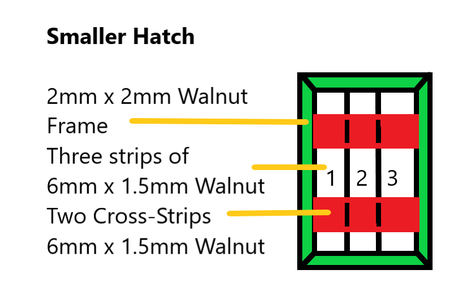
Graphic illustration of how the smaller hatch is assembled.
The assembly of the hatches were straightforward but when gluing them to the deck, make sure that these are properly weighed down. The deck does not only have a marked curve from stern to bow but also from the middle of the deck outwards.
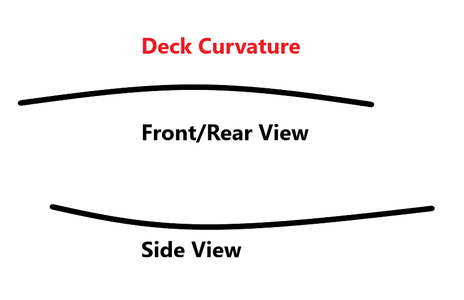
The compound deck curvature calls for the hatches to be weighed down properly during installation.
The deck is planked with 4mm wide and 0.7mm thick Abachi planks which I really love working with. Against the dark walnut of the hull the light-colored Abachi forms a beautiful contrast. Another advantage is that it offsets the deck fittings nicely. When it comes to planking Deck A it is important to realize that very little of Deck A will be visible. The Upper deck will cover it completely with the exception of a hatch and grating which may offer a glimpse of proceedings below deck.
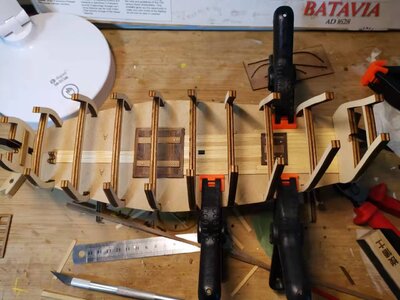
Start of the deck planking.
As a result of that, Piet has only partially planked Deck A. The only reason why I planked the whole deck is to keep open the option of installing cannons. In that case, the gun carriages obviously have to be mounted on a relatively even surface. Piet however, chose from the outset to build the ship with the gunports closed and therefore there was no need for him to plank any further.
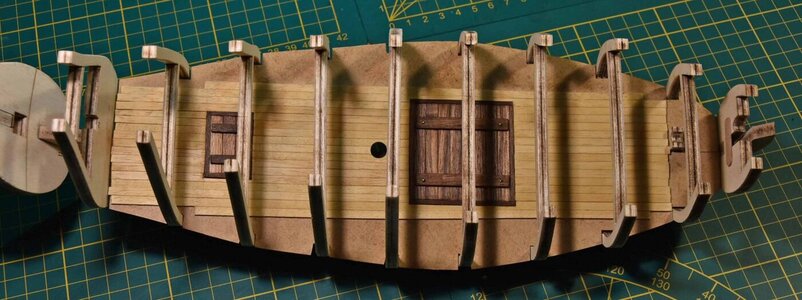
This picture shows how far Piet planked the deck. As there is nothing else that is going to be done to this part of the deck or hatches, Piet finished his Deck A assembly with Danish Oil. Photograph: @pietsan Piet Sanders
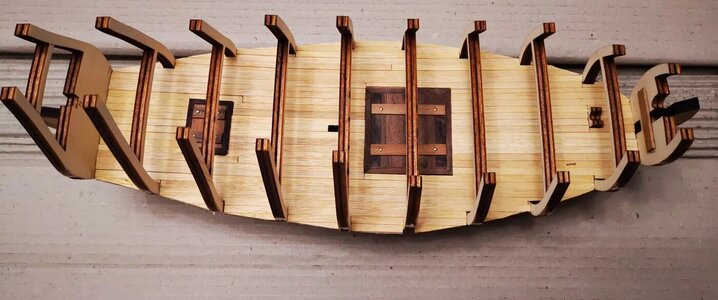
My completed Deck A. The fact that only the two hatches MAY be visible after the upper deck is installed, meant that I did not bother with planking patterns, and simulated caulking or nailing-effects.
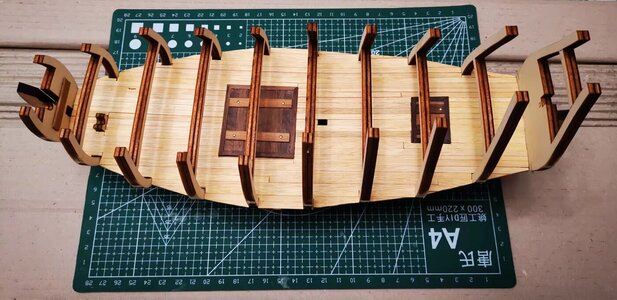
No, my Willem Barentsz does not come with a rectangular mast! As I am contemplating installing cannons, I have not oiled the deck as that would have an effect when the gun carriages need to be affixed to the deck.
That is all for tonight dear friends. I want to thank each and everyone of you who is following this build, commenting and actively taking part. I have a feeling that this is going to be a special build for me as the little ship has already crept into my heart!
Take care, enjoy your building and cherish your loved ones.
Warmest wishes
H
The instructions call for the hatches to be assembled from walnut strips of 6mm width and 1.5mm thickness with a 2mm x 2mm walnut strip as frame. In the case of the bigger hatch, I found that 7 strips plus the frame give the desired size whilst the smaller hatch can be made up of three strips plus the frame. In both cases the strips run across the deck (starboard-port direction) and are finished by two 6mm strips which are mounted lengthwise (stem-to-stern) on top of the hatch.

Front hatch installed.

Graphic illustration of the how the front/larger hatch is composed.

Smaller hatch at the stern installed.

Graphic illustration of how the smaller hatch is assembled.
The assembly of the hatches were straightforward but when gluing them to the deck, make sure that these are properly weighed down. The deck does not only have a marked curve from stern to bow but also from the middle of the deck outwards.

The compound deck curvature calls for the hatches to be weighed down properly during installation.
The deck is planked with 4mm wide and 0.7mm thick Abachi planks which I really love working with. Against the dark walnut of the hull the light-colored Abachi forms a beautiful contrast. Another advantage is that it offsets the deck fittings nicely. When it comes to planking Deck A it is important to realize that very little of Deck A will be visible. The Upper deck will cover it completely with the exception of a hatch and grating which may offer a glimpse of proceedings below deck.

Start of the deck planking.
As a result of that, Piet has only partially planked Deck A. The only reason why I planked the whole deck is to keep open the option of installing cannons. In that case, the gun carriages obviously have to be mounted on a relatively even surface. Piet however, chose from the outset to build the ship with the gunports closed and therefore there was no need for him to plank any further.

This picture shows how far Piet planked the deck. As there is nothing else that is going to be done to this part of the deck or hatches, Piet finished his Deck A assembly with Danish Oil. Photograph: @pietsan Piet Sanders

My completed Deck A. The fact that only the two hatches MAY be visible after the upper deck is installed, meant that I did not bother with planking patterns, and simulated caulking or nailing-effects.

No, my Willem Barentsz does not come with a rectangular mast! As I am contemplating installing cannons, I have not oiled the deck as that would have an effect when the gun carriages need to be affixed to the deck.
That is all for tonight dear friends. I want to thank each and everyone of you who is following this build, commenting and actively taking part. I have a feeling that this is going to be a special build for me as the little ship has already crept into my heart!
Take care, enjoy your building and cherish your loved ones.
Warmest wishes
H
Last edited:
- Joined
- Sep 3, 2021
- Messages
- 5,155
- Points
- 738

And not being the least bit chauvinistic!Hi Grant! Great to see you here - a South African who lives in Melkbosstrand and who is building such an exquisite HMS Victory as you are - can gatecrash my party anytime !
- Joined
- Jan 9, 2020
- Messages
- 10,544
- Points
- 938

Of course not!And not being the least bit chauvinistic!

Lovely work on the decking!
- Joined
- Jan 9, 2020
- Messages
- 10,544
- Points
- 938

Thank you very much Paul. I am very happy with the effect of the natural wooden colors.Lovely work on the decking!
Great start Heinrich. I like the contrast.
Jan
Jan
Heinrich, my old friend, what a beautifull introduction you placed here, if you don't mind i'll take the backseat, and drop in sometimes to see how you are doing with this fenomenal ship of our history.
I wish you a lot of fun and many more of this historical points of interests
Greetings, Peter
I wish you a lot of fun and many more of this historical points of interests
Greetings, Peter



